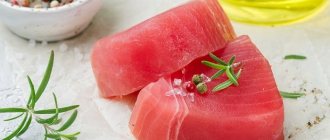Tilapia is a representative of freshwater fish of the cichli family. This fish is often called tilapia. This fish has more than a hundred different species. The expanses of Asia Minor are considered the native waters for tilapia, from where tilapia spread to large areas of Asia and even Africa. The fish has a tall, short and slightly compressed body on the sides.
Most often, the color of tilapia is a solid silver-gray, although some species are characterized by a green color. The fish's head is large, as are its eyes. The fish has long fins along its body. There is a version that the fish got its name in honor of an African tribe living on Lake Malawi. However, earlier the fish had many other names: it was both “St. Peter’s fish” and “river chicken”, the Arabs called it “musht”, and the Israelis called it “amnun”.
Tilapia has a fighting character: if threatened, it carefully protects its territory from uninvited guests. Thanks to a strong signaling system, individuals of this genus are able to form strong pairs. It is also curious that the female incubates her fry in the oral cavity. Despite the fact that within the genus
Tilapia species differ from each other in their feeding method: some prefer plant foods, others feed on bottom sediments, and still others even feast on plankton - in general, the fish is omnivorous. By the way, this is why researchers consider tilapia to be harmful, but more on that below. Although the fish has a rather limited habitat, it is bred with great success in fish farms not only in Africa and Asia, but also in Latin America, the USA and other non-European countries.
The fish is popular not only among professional chefs, but also among ordinary seafood lovers. The fact is that the tender meat and juicy taste of the fish, as well as many simple ways to prepare tilapia, allow you to turn it into a culinary masterpiece in a matter of minutes.
Composition of tilapia
Tilapia contains a lot of vitamins and microelements. In addition, fish contains balanced protein necessary for the full development of muscles and cells. Tilapia contains vitamins, B9, B12. Fish also contains vitamin, and. Among the minerals that make up tilapia are potassium, calcium, magnesium and sodium. Tilapia also contains phosphorus and iron.
How to eat tilapia
If there are no contraindications to eating fish, then there are no special restrictions on the amount of product consumed. It is recommended to eat 2-3 fish dishes per week to replenish the reserves of substances important for full development. Boiling or steaming is the best way to process fish. Baking and salting are not much inferior. Lightly salted fish retains beneficial substances, but parasites and bacteria remain. Fried fish is tasty, but it loses more than half of its beneficial properties.
Useful properties of tilapia
Tilapia, like other types of fish, is rich in easily digestible protein. This component is completely balanced in amino acid composition, which allows the fish to digest and assimilate well. Another advantage of tilapia is its low amount of calories. The calorie content of tilapia is only 96 kcal per 100 grams. Of these, almost 21 grams are proteins, and 1.7 grams are fats. There are no carbohydrates in fish. Nutritionists recommend paying attention to the fact that tilapia contains about 50 mg of cholesterol, and the content of saturated fatty acids reaches 0.77 grams.
The composition of tilapia is rich in various vitamins responsible for the vital functions of human organs. Thiamine takes an active part in the process of nerve excitation at synapses. It also protects cell membranes from the effects of toxins and breakdown products. It is an important protector of the entire body from negative environmental factors.
Vitamin B2 is very important in the process of iron absorption; without it, this element cannot be completely broken down. Riboflavin takes an active part in protecting the body from viruses and bacteria. Its role for the immune system is significant. Thanks to the vitamin, a person can resist various ailments. The benefits of vitamin B5 are most pronounced for hormonal levels. It stimulates the production of glucocorticoids in the adrenal glands. For this reason, this element is included in drugs for arthritis, colitis and allergies. Vitamin B5 is also important for the heart. It protects this organ from the occurrence of illnesses and strengthens blood vessels.
Pantothenic acid is one of the components for the production of antibodies. They help strengthen the immune system and ensure the absorption of other vitamins in the blood. Also, the benefit of vitamin B5 is that it helps synthesize neurotransmitters. The beneficial properties of folic acid are manifested for the immune system. Vitamin B9 affects tissue growth and supports the functioning of the cardiovascular system. Thanks to this component, the synthesis of amino acids and enzymes occurs in the body. Folic acid has a positive effect on the functioning of the hematopoietic system, as it controls the functionality of leukocytes. The benefits of vitamin B9 are evident for the liver and digestive system.
B vitamins have a positive effect on the nervous system. They prevent the onset of depression and senile dementia. By regularly consuming foods containing vitamin B12, confusion and sclerosis can be avoided. Cyanocobalamin is necessary for the body to ensure cell growth. It helps curb mental decline due to AIDS. Thanks to vitamin E, it improves blood circulation. This vitamin is also necessary for tissue regeneration. Doctors believe that vitamin E helps cope with PMS (premenstrual syndrome. Without vitamin E, fibrotic breast diseases cannot be treated.
In addition, vitamin E provides protective functions of cellular structures from destruction by free radicals. It acts as an oxidant. Thanks to vitamin E, the blood is fully enriched with oxygen. This process affects a person’s well-being by regulating the feeling of fatigue. Without sufficient vitamin E, blood clotting and wound healing are impossible. Having enough vitamin E in the body can help prevent the formation of scars from some wounds. This component improves appetite and stomach function. It is an important vitamin for the reproductive system, as it helps ensure its active functioning and corrects the decrease in sperm content in the seminal fluid. An important function of vitamin K is anabolic. This vitamin helps normalize the body's energy supply.
The benefit of vitamin K is that it is able to remove waste products and toxins from the body. When spoiled or harmful foods enter the intestines, the vitamin reduces their harmful effects on the liver and cells of the human body. Thus, it saves tissues and organs from damage. Thanks to the effects of this vitamin, blood sugar and diabetes symptoms are reduced.
Use in healthy and therapeutic nutrition
Cooks and doctors advise everyone who cares about their diet to include tilapia in their diet. The obvious advantage of the product is not only its composition and calorie content, but also its gastronomic characteristics .
Once cooked, tilapia does not have a distinct fishy aroma. Even though it is a freshwater fish, it is often called a saltwater fish. The neutrality of tilapia meat is enhanced by different sauces. Tender dietary fish fillet rolls perfectly into rolls, which can be stuffed with asparagus, spinach or champignons. Tilapia can be either a complete fish dish or part of a side dish. Pair with tilapia:
- potato
- cereals (buckwheat, rice, barley, lentils);
- vegetables (carrots, zucchini, cauliflower, tomatoes, green peas);
- citrus fruits (lemons, oranges for sauces);
- eggs;
- greenery;
- dairy products (hard cheese, mozzarella, sour cream);
- mayonnaise;
- mustard;
- honey.
Harm of tilapia to the body
Experts did not have a unanimous opinion on tilapia. For example, scientists from America believe that tilapia is not a healthy fish, since the content of beneficial omega-3 fatty acids in it is minimal, while omega-6 fatty acids, potentially dangerous to the body, are found in excess.
People with heart pathologies, as well as those suffering from asthma, arthritis and allergies are advised to avoid this fish. Also, harm to tilapia is possible due to its uncleanliness. As mentioned above, the fish is omnivorous, which means that it eats not only small insects and plants, but does not disdain carrion, as well as the decomposed remains of other fish, etc. There are often cases when tilapia also consumes household waste, which can end up in the rivers where it lives. Unfortunately, it is almost impossible to control this fact. However, in contrast to these statements, other nutritionists say that tilapia can be eaten. The main thing is to carefully process the fish and subject it to heat treatment.
What kind of fish is tilapia?
The fish belongs to the cichlid family . Unpretentious tilapia very easily adapts to environments with different temperatures and low oxygen content in the water.
An omnivorous fish can survive almost anywhere. Indiscriminate in food, it feeds on algae, plankton and other organic matter. She is rightly accused of being unscrupulous in her diet choices, but this does not make the tilapia any less tasty. Fish also has a special place in a healthy diet.
Tilapia fish is found in freshwater bodies , but if necessary, it can survive even in salty sea water. Externally, it is distinguished by a short but tall body, compressed from the sides. In this way, tilapia is a bit like flounder. Tilapia has a relatively large head and large eyes. As for the color, it is most often silver-gray, sometimes with a greenish tint.
Tilapia is bred mainly in artificial reservoirs in Asian countries, the USA and Latin America , as well as in China . Fish itself is a healthy product, but housewives often choose it based on the presence of small bones. Compared to other relatives, tilapia wins in this sense. Its fillet is easy to clean from dangerous and unpleasant “thorns”, and then fry, bake or boil.
Fried tilapia
One of the most popular recipes for preparing tilapia is probably frying it. To make the fish more juicy and retain its tenderness, it is better to fry it in batter.
For this you will need:
- 8 pieces tilapia fillets;
- 50 ml vegetable oil;
- 300 g flour;
- 2 eggs;
- salt and pepper to taste.
Cooking fried tilapia
- Initially, you need to rinse the fish carcass under running water. Then cut the fish fillet into pieces and leave aside while the batter is prepared.
- To do this, you need to break a few eggs into a bowl and add a pinch of salt. Place flour and spices in another plate.
- Now dip each piece of fish into a plate with flour and then with the egg. Make sure the fish is coated on both sides. Heat a frying pan with oil. Place pieces of fish on it. Fry the tilapia fillet on each side for 7-8 minutes until it acquires its characteristic color. It is better to serve fish warm.
How to use it for weight loss
The low calorie content of the product allows it to be included in the diet. Its delicate taste will appeal to everyone who is actively involved in sports and leads a healthy lifestyle. Tilapia is a tasty and complete source of post-workout protein. She gets ready quickly. You can fry it in an egg or bake it in foil, sprinkle with herbs, and a nutritious, delicious dinner is ready.
Tilapia can be used in any diet that requires the consumption of fish fillets. For comparison, 100 grams of beef fillet contains more calories than the same serving of fish.
Harm and contraindications
In some sources, tilapia is called the fish of the Apostle Peter. Believers believe that it was tilapia that Jesus fed five thousand of his followers at one time. But not everyone is so optimistic about the health benefits of tilapia. According to scientists, the ratio of omega-3 and omega-6 fatty acids should be equal, as confirmed by the example of red fish. In the situation with tilapia, the ratio is 1:3 , where omega-6 is in the majority. In some cases, tilapia is considered potentially hazardous to health, and instead of being beneficial, this fish can cause harm to the following categories of people:
- people with heart pathology;
- asthmatics;
- patients with autoimmune diseases;
- suffering from arthritis.
Yet tilapia remains a popular product among fish lovers in many countries thanks to an alternative opinion.
The amount of fat in fish is so low that it cannot harm the body.
In this case, the fish is dangerous only for people with individual intolerance to the product. Tilapia is not inferior in taste to sea fish , despite the fact that it lives in fresh waters. It is quick and easy to prepare and can be combined with many foods. Tilapia is appropriate in dietary diets; it is recommended in the diet of children, expectant and nursing mothers, and the elderly. It is low-calorie and healthy. The only thing that calls into question its harmlessness to health is the assumption about the ratio of fatty acids. Given this, tilapia is contraindicated for asthmatics, arthritis, heart and autoimmune diseases.
We invite you to share your tilapia recipes. Tell us how you like the taste of fish and what methods you use to prepare it.
Steamed Tilapia recipe. Calorie, chemical composition and nutritional value.
Nutritional value and chemical composition of “Steamed Tilapia”.
The table shows the nutritional content (calories, proteins, fats, carbohydrates, vitamins and minerals) per 100 grams of edible portion.
| Nutrient | Quantity | Norm** | % of the norm in 100 g | % of the norm in 100 kcal | 100% normal |
| Calorie content | 112.5 kcal | 1684 kcal | 6.7% | 6% | 1497 g |
| Squirrels | 23.5 g | 76 g | 30.9% | 27.5% | 323 g |
| Fats | 2 g | 56 g | 3.6% | 3.2% | 2800 g |
| Water | 74.3 g | 2273 g | 3.3% | 2.9% | 3059 g |
| Ash | 1.089 g | ~ | |||
| Vitamins | |||||
| Vitamin B1, thiamine | 0.048 mg | 1.5 mg | 3.2% | 2.8% | 3125 g |
| Vitamin B2, riboflavin | 0.074 mg | 1.8 mg | 4.1% | 3.6% | 2432 g |
| Vitamin B4, choline | 49.79 mg | 500 mg | 10% | 8.9% | 1004 g |
| Vitamin B5, pantothenic | 0.571 mg | 5 mg | 11.4% | 10.1% | 876 g |
| Vitamin B6, pyridoxine | 0.19 mg | 2 mg | 9.5% | 8.4% | 1053 g |
| Vitamin B9, folates | 28.114 mcg | 400 mcg | 7% | 6.2% | 1423 g |
| Vitamin B12, cobalamin | 1.851 mcg | 3 mcg | 61.7% | 54.8% | 162 g |
| Vitamin D, calciferol | 3.631 mcg | 10 mcg | 36.3% | 32.3% | 275 g |
| Vitamin D3, cholecalciferol | 3.631 mcg | ~ | |||
| Vitamin E, alpha tocopherol, TE | 0.469 mg | 15 mg | 3.1% | 2.8% | 3198 g |
| gamma tocopherol | 0.117 mg | ~ | |||
| Vitamin K, phylloquinone | 1.6 mcg | 120 mcg | 1.3% | 1.2% | 7500 g |
| Vitamin RR, NE | 4.5721 mg | 20 mg | 22.9% | 20.4% | 437 g |
| Betaine | 25.42 mg | ~ | |||
| Macronutrients | |||||
| Potassium, K | 353.77 mg | 2500 mg | 14.2% | 12.6% | 707 g |
| Calcium, Ca | 11.71 mg | 1000 mg | 1.2% | 1.1% | 8540 g |
| Magnesium, Mg | 31.63 mg | 400 mg | 7.9% | 7% | 1265 g |
| Sodium, Na | 60.91 mg | 1300 mg | 4.7% | 4.2% | 2134 g |
| Sera, S | 235.22 mg | 1000 mg | 23.5% | 20.9% | 425 g |
| Phosphorus, P | 199.1 mg | 800 mg | 24.9% | 22.1% | 402 g |
| Microelements | |||||
| Iron, Fe | 0.656 mg | 18 mg | 3.6% | 3.2% | 2744 g |
| Manganese, Mn | 0.0434 mg | 2 mg | 2.2% | 2% | 4608 g |
| Copper, Cu | 87.86 mcg | 1000 mcg | 8.8% | 7.8% | 1138 g |
| Selenium, Se | 48.966 mcg | 55 mcg | 89% | 79.1% | 112 g |
| Zinc, Zn | 0.3866 mg | 12 mg | 3.2% | 2.8% | 3104 g |
| Essential amino acids | |||||
| Arginine* | 1.496 g | ~ | |||
| Valin | 1.136 g | ~ | |||
| Histidine* | 0.551 g | ~ | |||
| Isoleucine | 1.089 g | ~ | |||
| Leucine | 1.878 g | ~ | |||
| Lysine | 2.12 g | ~ | |||
| Methionine | 0.695 g | ~ | |||
| Threonine | 1.113 g | ~ | |||
| Tryptophan | 0.246 g | ~ | |||
| Phenylalanine | 0.949 g | ~ | |||
| Nonessential amino acids | |||||
| Alanin | 1.429 g | ~ | |||
| Aspartic acid | 2.691 g | ~ | |||
| Glycine | 1.222 g | ~ | |||
| Glutamic acid | 3.764 g | ~ | |||
| Proline | 0.887 g | ~ | |||
| Serin | 0.952 g | ~ | |||
| Tyrosine | 0.797 g | ~ | |||
| Cysteine | 0.258 g | ~ | |||
| Sterols (sterols) | |||||
| Cholesterol | 58.57 mg | max 300 mg | |||
| Saturated fatty acids | |||||
| Saturated fatty acids | 0.7 g | max 18.7 g | |||
| 14:0 Miristinovaya | 0.062 g | ~ | |||
| 16:0 Palmitinaya | 0.497 g | ~ | |||
| 18:0 Stearic | 0.125 g | ~ | |||
| Monounsaturated fatty acids | 0.583 g | min 16.8 g | 3.5% | 3.1% | |
| 16:1 Palmitoleic | 0.116 g | ~ | |||
| 18:1 Oleic (omega-9) | 0.444 g | ~ | |||
| 20:1 Gadoleic (omega-9) | 0.023 g | ~ | |||
| Polyunsaturated fatty acids | 0.425 g | from 11.2 to 20.6 g | 3.8% | 3.4% | |
| 18:2 Linolevaya | 0.185 g | ~ | |||
| 18:3 Linolenic | 0.039 g | ~ | |||
| 18:3 Omega-3, alpha-linolenic | 0.039 g | ~ | |||
| 18:4 Steoride Omega-3 | 0.003 g | ~ | |||
| 20:2 Eicosadiene, Omega-6, cis, cis | 0.003 g | ~ | |||
| 20:3 Eicosatriene | 0.012 g | ~ | |||
| 20:4 Arachidonic | 0.027 g | ~ | |||
| 20:5 Eicosapentaenoic acid (EPA), Omega-3 | 0.006 g | ~ | |||
| Omega-3 fatty acids | 0.2 g | from 0.9 to 3.7 g | 22.2% | 19.7% | |
| 22:5 Docosapentaenoic acid (DPA), Omega-3 | 0.05 g | ~ | |||
| 22:6 Docosahexaenoic acid (DHA), Omega-3 | 0.101 g | ~ | |||
| Omega-6 fatty acids | 0.2 g | from 4.7 to 16.8 g | 4.3% | 3.8% |
The energy value of steamed tilapia is 112.5 kcal.
Primary Source: Created in the application by the user. Read more.
** This table shows the average levels of vitamins and minerals for an adult. If you want to know the norms taking into account your gender, age and other factors, then use the “My Healthy Diet” application.










